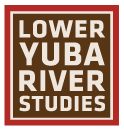Surface Flows
Introduction
Data to quantify and track water flowing into, through, and out of the lower Yuba River is collected by a variety of organizations for numerous purposes. Traditional gaging stations measure hydrostatic pressure, convert the raw data into water surface elevations (i.e. stages), and then estimate water discharge from stage through the use of empirical regression equations from ~30 direction observations each year. Some of these same types of gages are used on the river to simply measure stage, which a variable needed for some studies. A vareity of other technologies are used to observe flow through dams and diversions, depending on the nature of the structure.
Where to Find LYR Flow Data?
The data from traditional discharge gaging stations are available to the public at no cost. The California Data Exchange Center provides provisional real-time and historical 15-minutes, hourly, and daily data, while the United States Geological Survey (USGS) water resources website provides both provisional real-time data, quality-checked daily data, and numerous water statistics.
LYR Inflows
- The primary inflow to the LYR comes from the Yuba catchment and is the outflow from facilities at Engebright Dam. The Yuba River USGS gaging station #11418000 is near Smartville, CA. CDEC uses the identifier "YRS" for this gage in its system. This gage is located in the canyon downstream of the dam, not on the dam itself. Although the gage is in a bedrock canyon, the gage itself is situated in a pool whose water surface elevation is controlled by a downstream mound of mixed-sized sediment that forms a plug in the river. When the river floods the mound of sediment changes and thus the stage for each flow changes too. As a result, the stage-discharge relation is dynamic and requires regular re-calibration. The record for this gage spans from 10/1/1941 to present.
- There are independent gages on each Englebright Dam outflow facility as well as a gage recording the flux of water spilling over the dam during floods. There are 3 outflow facilities, Narrows 1, Narrows 2, and the bypass tunnel. The crest of the dam has a shape with a designed relation between reservoir stage and spill, so spill is computed based on monitoring reservoir stage. Spill begins when the reservoir elevation exceeds 527.2 feet.
- The Deer Creek USGS gaging station #11418500 is at the Mooney Flat Road bridge over Deer Creek near Smartville, CA. It is located in a bedrock channel. CDEC uses the identifier "DCS" for this gage in its system. The record is from 10/1/1935 to present.
- The Schubert subcatchment at the University of California Sierra Foothills Research and Extension Center flows into the LYR in the Narrows and has been gaged for over 60 years. It has a small amount of flow, but it long record has been used to study the influence of different land management practices on runoff generation and water quality, particularly with respect to cattle grazing. Data may be obtained by contacting the UC Sierra Foothills Research and Extension Center.
- Dry Creek is gaged at Collins Lake by Browns Valley Irrigation District (BVID). Typical controlled releases are ~2 cfs. Uncontrolled winter floods occur and appear to transport sediment and alter Dry Creek’s morphology, but the fluvial geomorphology has not been documented as of yet.
- No other minor tributaries (e.g. Big Ravine and Blue Point mine) have gages.
LYR In-River Flows
- The Yuba River USGS gaging station #11421000 is near Marysville, CA. This gage is located downstream of Daguerre Point Dam, agricultural water diversions, and natural groundwater recharge, so its values are often lower than those recorded at the Smartville gage. Also, it is located relatively far upstream of the confluence with the Feather River, because flow fluctuations in the Feather River cause significant water level variations in the lowermost LYR, precluding the ability to create an independent stage-discharge relation for the LYR near its mouth. CDEC uses the identifier "MRY" for this gage in its system. The record is from 10/1/1943 to present. The National Oceanic and Atmospheric Administration (NOAA) operates a river discharge forecast center. Flows for the next 5 days are forecasted for this gage at this link, but they are often incorrect given the immense challenge of predicting the weather driving runoff as well as the Yuba catchment's natural water storage capacity.
LYR Outflows
The primary outflow is water that leaves the LYR by flowing into the Feather River, but water also leaves via diversions and groundwater recharge. Water diverted under YCWA’s water right permits is delivered to Brophy Water District (BWD), Browns Valley Irrigation District (BVID), Cordua Irrigation District (CID), Dry Creek Mutual Water Company (DCMWC), Hallwood Irrigation Company (HIC), Ramirez Water District (RWD), Wheatland Water District (WWD), and South Yuba Water District (SYWD).
- BVID receives water at the Pumpline Diversion Facility, located one mile upstream from Daguerre Point Dam.
- CID, HIC, and RWD receive water through the Hallwood-Cordua Canal (North Canal), located on the north abutment of Daguerre Point Dam.
- BWD, SYWD, and DCMWC receive water through the South Yuba Canal (South Canal), located on the south side of the Yuba River slightly upstream of the south abutment of Daguerre Point Dam. YCWA also delivers surface water to the City of Marysville for use at Lake Ellis.
- The Marysville gage is commonly used to estimate the outflow to the Feather River.
Bibliography
Overall, the LYR is fairly well gaged, providing the baseline data necessary to evaluate hydrological drivers of geomorphic processes and ecological functions in the river. There exist several documents that report on LYR surface flows.
